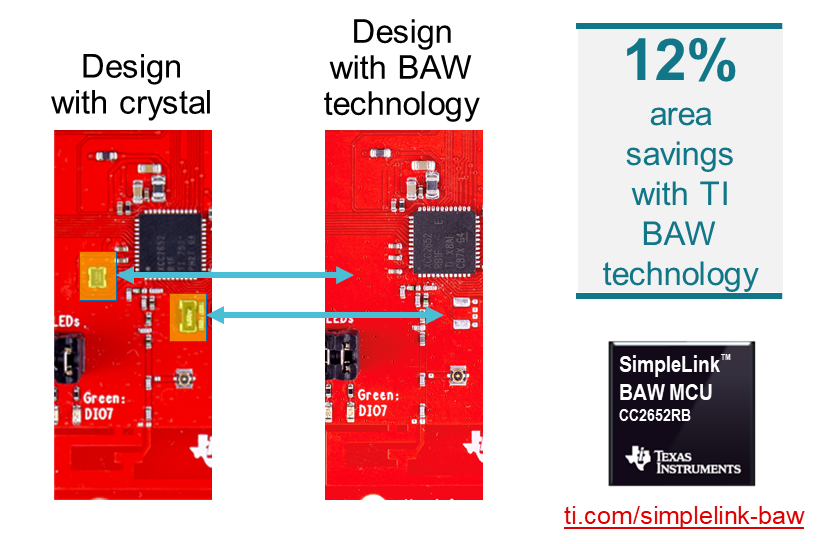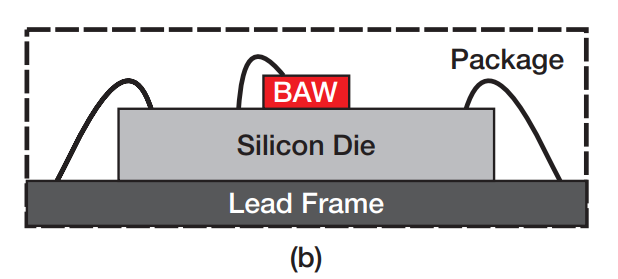SSZT358 january 2020 CC2652R , CC2652RB

Innovation in the semiconductor industry is often about adding on to an existing product, but less is more when it comes to design. At TI, we looked at the electronic build of materials (BOM) surrounding our SimpleLinkTM wireless MCUs and wanted to remove the external high-frequency crystal without compromising any features or capabilities. This is where revolutionary bulk acoustic wave (BAW) resonator technology comes into play.
Whether you are designing a space constrained building security system or a power tool that will be used in a harsh physical environment, you can use BAW resonator technology.
We integrated our BAW resonator into a multiprotocol 2.4-GHz MCU resulting in the world's first crystal-less, wireless MCU device: CC2652RB. This device supports communication over Bluetooth® Low Energy, ZigBee and Thread protocols, and is available in a 7-mm by 7-mm quad flat no-lead (QFN) package.
How does it work?
The CC2652RB is a variant of our CC2652 family of devices that integrates the BAW resonator die inside the package as shown in Figure 1. This BAW die generates the high-speed 48-MHz clock signal an external quartz crystal would typically generate, allowing the external crystal to be removed from the board.
 Figure 1 The BAW Technology Fabricated on Silicon Die.
Figure 1 The BAW Technology Fabricated on Silicon Die.What are the benefits of using BAW?
PCB Space Savings
Space savings can be essential in applications such as wearable medical devices. The CC2652RB is designed for space-constrained wireless applications. Removing the external 48-MHz crystal reduces the footprint of our traditional 7mm x 7mm QFN wireless MCUs by 12%. This also provides you increased flexibility for routing your sensors and peripherals to the GPIO pins.
Simplified Development
Quartz crystals are one of the most common pain points in the RF layout of wireless radios. They are often the source of issues, such as, noise, cross-talk or crystal frequency tuning. These issues often require new PCB spins to fix during development, increasing your development costs. All of these risks can be avoided by utilizing CC2652RB.
Robustness + Durability
Many of today’s innovative products reside in harsh environments. From the constant vibration of an industrial robot to the mechanical shock of dropped device, wireless devices need to reliably operate in many situations.
BAW resonator technology is a viable long term design option for rugged environments. It is more resilient to mechanical shock and vibration environments, with 3x lower ppm variation than an external quartz crystal when tested against the industry standard, MIL-SD-883H. The device is also rated up to a 10 year lifetime, versus the typical five to six years of a quartz crystal. This means a more accurate radio and fewer timing and transmission errors over nearly double the lifetime.
Quartz crystals are also more susceptible to breaking under mechanical shock, terminating the wireless functionality of the device. If the external crystal shatters it would need full replacement to restore wireless functionality. This fragile part can be removed from your application with the BAW resonator.
Physical Security
Utilizing BAW resonator technology diminishes a potential point of weakness in MCU security. Removing the external crystal mitigates the opportunity for a timing related side channel attack on the system.
I currently use CC2652R, how do I migrate to the CC2652RB?
Migrating from CC2652R to CC2652RB is very simple. The two devices are pin to pin compatible with 7-mm-by-7-mm QFN packaging. Because the devices use the same silicon inside the package, it is as simple as not connecting the pins you would have originally connected to the 48-MHz external crystal.
From a software perspective, the change is very simple: you only have to change the clock source register. The rest of your software seamlessly transitions to the CC2652RB thanks to the common SimpleLink platform software development kit (SDK) utilized by all SimpleLink devices
Designing with CC2652RB is easy. You’ll find that migrating from CC2652R to CC2652RB allows for a reduced overall footprint and a simplified design process.
How do I get started with BAW?
Step 1: Buy the LP-CC2652RB LaunchPad development kit
Step 2: Download the CC13x2-CC26X2 SDK
Step 3: Complete the Out-of-Box experience and take the SimpleLink Academy trainings
Learn More about TI BAW Technology and Products
- For more information on TI BAW technology and products, visit www.ti.com/baw.
- Are you ready for BAW? Find out in our short technical article.